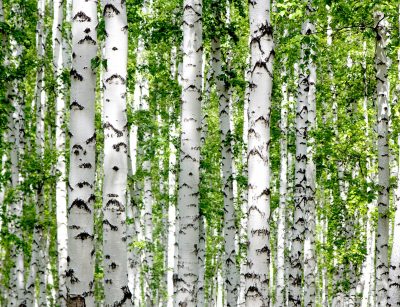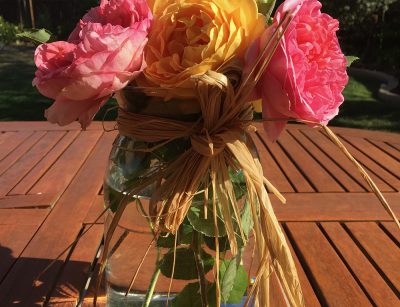
Growing and enjoying your own flowers is only half the fun of gardening. Cutting, making floral arrangements, and bringing them indoors provides even more enjoyment of your hard work, and becomes a hobby of its own!
If you’re hoping to add unique elements to your home’s decor, you might be feeling a bit tired of the standard floral arrangements. This can be especially true during the winter season when you have fewer blooms available for use. With a little creativity and a fresh set of eyes, you can still find plenty of natural elements available in your own backyard. Learn to combine them in new ways, and you have an original, artistic arrangement that is perfect for your mantle or dining table.
Take a small child along. Children have a way of looking at the world with a different perspective and find beauty in things we don’t often notice as adults. You might be surprised at how innovative and yet practical their design ideas can be!
Open your mind to different possibilities. An arrangement doesn’t need to be composed only of flowers. Twigs, stems full of ripe berries, evergreen leaves, dried grasses, pinecones, and plenty of other natural elements are available in your yard. Consider how you can use them to complement one another.
Of course, remember that arrangements don’t only belong in vases. Get creative with your containers, too. Mason jars, recycled planter pots and kitchen containers can all be used to make unique arrangements.
Consider the season. The great thing about floral arrangements is that you can change them out frequently, keeping your interior decor fresh and interesting. While you might feel that tulips signal spring and roses symbolize summer, consider other natural elements that reflect the season. Dried seed heads, fruits, autumn flowers, and more are becoming increasingly popular in the floral design world.
Getting outside and looking at your yard in a new way can spark inspiration, and help you to appreciate all that nature has to offer. But if you realize that your yard lacks a few crucial elements, you might feel inspired in a different way. Give us a call and we can help you choose new plants to add more variety to your landscape.
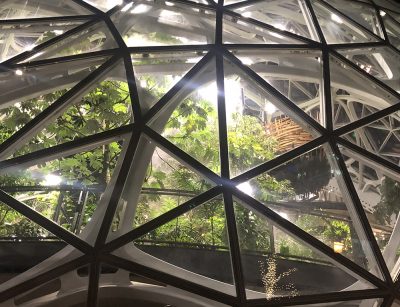
Think about the typical office, and in your opinion, what seems to be missing? Most offices feel sterile, tense, perhaps a little cold, and definitely stifling. If you’re like a lot of people, you might even dread going to the office each day.
In fact, many of us notice that our creativity plummets in the office and that our best ideas come to us in other spaces. Don’t you feel more energetic and alive when walking through the park, or hiking in a national forest? Certainly more than you do while trapped inside a modern office building. It’s a common problem and one that Amazon’s Seattle Spheres was created to address.
The inspiration behind the idea is both simple and revolutionary: If workers feel more energized, focused, and creative outdoors, then why not bring the outdoors into the office?
The large glass structures were constructed to allow maximum light into the building and then were filled with living walls and lush gardens. When the rest of the world turns gray and drab from autumn into winter, the abundant plant life inside the Seattle Spheres remains as soothingly green as ever.
In May of 2017, the horticulture team installed the very first plant in the Spheres; an Australian tree fern arrived on an Amazon Prime truck and become the first of 40,000 individual plants now thriving inside the dome.
Today, the Seattle Spheres house not only Amazon offices but also serve as an educational opportunity for students from surrounding areas. And of course, the Spheres provide a model for the rest of us. While we can’t all construct our very own multimillion-dollar biodomes, we can all strive to bring more of the outdoors into our office spaces.
Plants clean our air, provide soothing ambiance, and spark creativity. If the Seattle Spheres intrigue you, consult with us about how you can incorporate ferns, succulents, and living walls into your own office space.
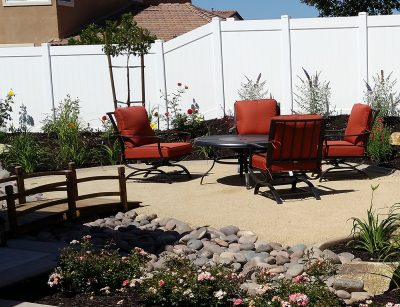
At this time of year, as we celebrate Valentine’s Day, many of us focus on ways to bring a bit more romance into our lives. Maybe you’re planning a special date, or just wish you had a private space in which to relax on a regular basis. A soothing backyard retreat would even make a great Valentine’s Day present! Keeping that in mind, here are a few ideas for creating your own private backyard retreat.
Keep it intimate. Your retreat space should provide enough space for two people to comfortably use it. Consider that when arranging the space and choosing seating.
Consider a theme. Would you enjoy a soft, grassy spot to practice yoga? Or is a cozy reading nook more your style? Consider how you will want to use the space so that you can design shapes, colors, and materials accordingly.
Make it cozy. A wall of lattice (perhaps with climbing vines), an arbor or pergola, or a wall can separate your special space from the rest of the yard. A neutral color theme provides a soothing ambiance.
Think about noise barriers. To both reduce street noise and protect your private conversations, a noise barrier such as shrubbery or a water feature might be in order. The water feature will engage another sense and make it more pleasant to relax.
Consider nighttime use. A fire pit or twinkly outdoor lighting could be the perfect way to finish your special space. Make it perfect for late-night drinks and conversation with that special someone.
Sometimes a relaxing walk through a garden is just what you need to inspire a new project. Give us a call and we’ll help you select lush plants, romantic flowers, and other elements to help you complete your perfect backyard retreat.
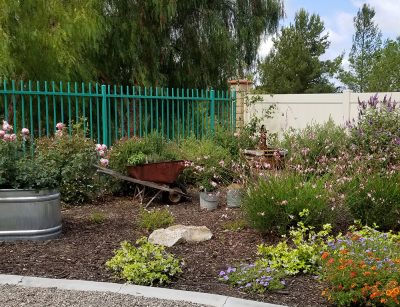
You might already be familiar with the concept of focal points in visual arts, like painting, or as they are used in interior design. But you can (and should) also create focal points in your landscape design as well.
Why focal points? A focal point serves two main purposes: First, to draw the eye toward a particular part of the yard that you wish to emphasize. Second, to draw the eye away from an area that perhaps isn’t the loveliest.
For example, a lovely wrought iron gate might draw the eye toward your prized rose bushes. Likewise, a water feature in the center of the yard might keep the focus there, and away from an unsightly area off to the side.
Use focal points sparingly. An effective focal point captures the viewer’s eye, and brings an area of the yard into focus. It should compliment and flow with, but not overwhelm other nearby elements. Conversely, a jumbled collection of objects would be too busy, and would not allow the eye to rest.
Using objects as focal points. While certain plants can also make for terrific focal points, there are a few problems with relying solely upon them. First, many plant species tend to flow with the rest of the landscape, so you would need to choose something that is dramatic and really stands out. Second, the specimen would need to draw the eye year-round, and that’s a challenge for most trees, shrubs, and perennials.
When you opt for objects as your focal point, you can rely upon them to draw the eye to that particular area of the yard. You can then change the elements around the focal point periodically (such as planting different perennials according to their blooming times) to keep it interesting.
Get creative. The great thing about using objects as focal points is that you can really create something unique in your yard. You can opt for something classic like a water fountain, a metal obelisk or a gazing ball. You can go with something more unique like a salvaged, rebuilt stable or a large metal sculpture. Consider the items your neighbors are using in their gardens, and select something a bit different to really stand out among the crowd.
For more ideas on unique and interesting focal points and how to utilize them effectively in landscape design, contact us.
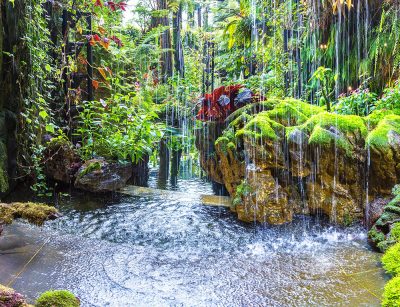
In tropical, mountainous regions, a phenomenon called a “cloud forest” often occurs. The combination of persistent rainfall and cooling air currents deflected upward by the slopes, create a unique environment for plants. Clouds quite literally brush the mountainsides throughout the day! Cloud forests are distinguished from rainforests by their typically mountainous terrain and the fact that they are almost constantly covered by a dense fog.
The heavy humidity allows mosses, ferns, lichens, and air plants to proliferate in these areas. In addition, cloud forests tend to host a number of species of animals that, because of thousands of years of evolution, are especially suited to that specific habitat and don’t exist anywhere else in the world.
For nature lovers, a visit to a cloud forest is a must. Some of the more famous cloud forests include:
Monteverde Cloud Forest in Costa Rica
The forest around Huitepec, an inactive volcano near San Cristobal, Mexico
El Cielo Biosphere Reserve in Tamaulipas, Mexico
Mount Kilimanjaro’s cloud forest in Tanzania
The Shola Forest in the Western Ghats of India
Springbrook National Park in Queensland, Australia
Mount Taranaki in New Zealand
Tandayapa Mindo in Ecuador
The Simien Mountains of Ethiopia
Cloud Forest at Gardens by the Bay, in Singapore – artificially created within a dome, but a terrific tourist destination, nonetheless!
Here in California, our own Santa Rosa island once hosted a booming cloud forest, along with native vegetation not found anywhere else in the world. Sadly, the arrival of European colonists in the 1800s brought non-native grazing animals, like horses, deer, elk, and pigs, which greatly impacted the ecosystem. Preservation efforts, through the Channel Islands National Park, seek to restore the balance of nature – and with it, hopefully, Santa Rosa’s cloud forest.
Back in 1970, cloud forests were estimated to cover about 50 million hectares worldwide. Annually, that figure drops by about 1.1 percent. Climate changes, population growth, and uncontrolled land use are gradually decimating these ecological wonders. Activism and responsible tourism can help to preserve the world’s cloud forests, but climate change begins with the individual. These lovely but delicate ecosystems are just one of the many reasons we should all consider the impacts of our daily actions on long-term climate change.

In 1984, TED talks began as a way to spread innovative ideas through short, powerful lectures. Short for Technology, Entertainment, and Design, TED talks now cover every conceivable topic, and have grown in popularity and exposure thanks to online channels like YouTube. The following are some of our favorite TED talks on outdoor topics.
How Trees Talk to Each Other. In this lecture, Suzanne Simard discusses how trees communicate with one another, even over vast distances. Sminard’s thirty years of experience have led to discoveries that will change your view of the natural world, and open your eyes to a reality none of us knew existed all around us.
Nature. Beauty. Gratitude. Louie Swartzberg’s stunning time-lapse images, paired with
Inspiring words from Benedictine monk Brother David Steindl-Rast offer up a relaxing meditation on the beauty of nature. This presentation will inspire feelings of gratitude for the wonders of nature all around us.
Is Your Yard Saving the Earth or Killing It? After twenty years in pharmaceutical marketing management, our very own John McCabe dove into a career change. Pursuing his first love of landscape design and horticulture, he founded McCabe’s Nursery and Landscape Construction in 2003. In this local TEDx talk, he discusses the ways in which individual homeowners can either contribute to environmental harm, or make choices to help save our planet.
The World’s Oldest Living Things. In this powerful TED presentation, photographer Rachel Sussman will challenge your ideas of life and longevity on Earth. These images of the world’s oldest living things include 2,000-year-old brain coral off the coast of Tobago, and an “underground forest” in South Africa that predates agriculture.
Nature is Everywhere – We Just Need to Learn to See It. A writer who focuses on environmental science, policy, and culture, Emma Marris hopes to challenge you idea of what “nature” really is. Hoping to inspire the next generation to notice and appreciate nature all around us, she describes her approach as “more interested in finding and describing solutions than delineating problems, and more interested in joy that despair”.
Did you enjoy these TED talks? We hope they inspired you to see nature all around you, to cherish the gifts offered by our Earth, and to do your part in preserving them.
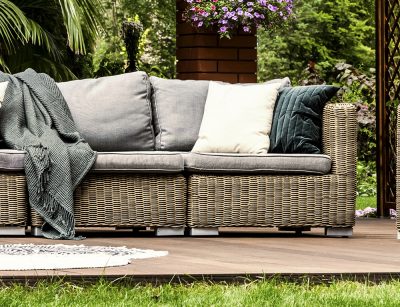
Last week, we began this two-part blog series to discuss outdoor design trends for 2019. If you’re renovating your backyard space between now and spring, read on to continue learning about this year’s hottest ideas and looks.
Modular sofas. In the past, selecting outdoor furniture always seemed to present one particular challenge: What type of seating configuration did you want? Whatever you chose was a semi-permanent commitment.
Luckily, designers have caught on to the idea of modular seating options. These versatile furniture sets can be rearranged as needed, allowing you to customize a space depending upon your changing needs.
Powder-coated aluminum. If you do need furniture that can be shifted frequently, the powder-coated aluminum trend might excite you. The lightweight material makes for outdoor furniture that is easy to move, and it tends to be more sleek and fits better into smaller spaces. Since powder-coated aluminum is durable and easy to clean, it’s also a great design choice for those who don’t want to spend a lot of time on upkeep.
New trends in outdoor fabrics. Gone are the days of boring outdoor upholstery! Continuing the trend of outdoor spaces that mimic indoor styles, designers have introduced a wider variety of customizable outdoor fabrics. Canvases are still durable and fast-drying, but also updated with softer elements for a sense of movement. We’re even seeing sheers and new outdoor velvets, so you can experiment with textures not traditionally used outside.
Classic neutral hues. As you update your outdoor space, you might notice this this year’s designs incorporate a variety of timeless neutral colors. That’s great news if you’re investing in new furniture, because you can count on these styles to continue their relevance for years in the future. You can easily update your decor with new throw pillows and accessories from time to time, without breaking the bank.
As you’re renovating your outdoor space, remember we’re here to help. Give us a call if you need more information on hardscaping, outdoor kitchens, gardening, or other components of a perfect backyard escape.
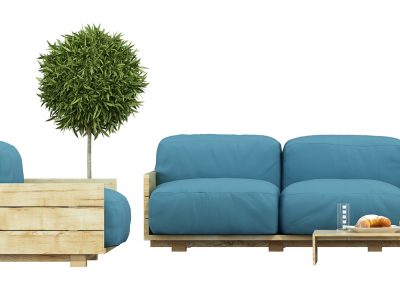
Yes, the new year has just begun, but barbecues and backyard hangouts with friends are just around the corner. Now is the time to renovate your outdoor space and get it ready for spring and summer. So, in this two-part blog series, let’s review some of the hottest trends that we’re expecting to see in 2019.
Mixed materials. Designers are experimenting with new, exciting combinations of materials. Update a traditionally plain, “matchy” patio decor by creating a more eclectic mix of materials like wood, metal, rope, concrete, stone, and upholstery.
Of course, you should keep exposure to elements in mind when choosing materials. Sun can fade some materials, while rain will take its toll on others. If your patio area is covered, you can enjoy more design freedom in that space.
Chunky timber. In particular, chunky timber-framed sofas, chairs, and tables appear to be growing in popularity. This material appeals to those who enjoy natural materials, and you can mix them with upholstery for a more luxurious look. Remember that some woods will “weather” when exposed to the elements, so research carefully before making your final selection.
Interesting details. While shopping for outdoor furniture and accessories, you might discover more interestingly detailed options than in years past. Webbing, brass brackets, and other “indoor only” details are moving outside. Designers are also experimenting with shapes like turned legs and sling-backs, once only seen in living and dining room furniture.
Seats are lower. The long and low profiles of contemporary furniture are also moving outdoors, dropping the seat height of sofas and chairs. Of course, many older people still prefer higher seating, so a mix of seat heights might be best if you entertain a wide age range.
These trend ideas might get your wheels turning, but stay tuned for next week’s blog. We’ll review a few more up-and-coming outdoor design trends, to help you create your ideal outdoor oasis.
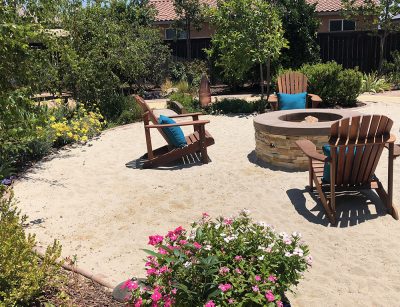
Travel is fun and rewarding, but it’s also expensive, time-consuming, and stressful. Sometimes we just don’t have the energy, time off of work, or budget to accommodate a trip to a far-flung location. But as the rising popularity of taking a “staycation” has taught us, taking a time-out at home can be quite restful and satisfying.
In fact, if you put a bit of effort toward building your own “staycation” spot at home, you can enjoy every weekend (or even week nights) feeling as though you’re relaxing at a resort.
Install a low-maintenance yard. Unless you truly enjoy mowing the lawn, all that work is just a drain on your time and energy. Installing a low-maintenance yard, such as xeriscaping, can reduce the amount of work needed to almost zero. If you can’t part with the look of a grassy lawn, artificial turf is another option. As for your garden, a built-in irrigation system takes the work out of regular waterings.
Jazz up your patio. Consider your outdoor space: Does it perform the functions you prefer in a relaxing environment? Have you created a space for entertaining friends? With the addition of just a few simple elements, you can make a boring porch or patio feel like a fancy hotel. Outdoor speakers allow you bring music into the space, fire and water features provide soothing natural elements, lighting allows for improved nighttime use, and an outdoor kitchen area allows for easy grilling or drink preparation. And of course, the right furniture gives you a plush place to sit.
What about a swimming pool? Obviously, this would be the most significant investment in an outdoor staycation environment, but kids would consider it essential. If you don’t have kids, a simple lap pool might suffice for adults.
Other bodies of water. A small koi pond lends a meditative feel to your backyard, and a waterfall can help to block noise from the road or nearby neighbors.
We’ve shared a number of ideas in this blog, but the options are limited only by your imagination. Give us a call to discuss your dream backyard space, and we can help you design and implement it. Soon you will know how it feels to live every day (at least partially) on vacation.

For outdoor gardeners, December can be a bit of a slow time. But that also means you get a chance to plan next year’s garden more thoroughly. If you’re the type of person who likes to keep up with trends, you might be interested to know the 2019 color forecast. You will be seeing these colors on everything from clothing to kitchen utensils, and yes – even your garden!
Intense shades. In digital design, artists can increase color saturation to produce incredibly deep, vivid colors. You might be surprised to learn that horticulturalists continually work on creating special breeds of flowers, with intense hues that almost appear “dialed up” by a digital artist!
As for the precise color forecast, designers say we will be seeing combinations of these particular hues next year:
Sherwin Williams has announced their color of the year: Cavern Clay, a soft terracotta tone with a Southwestern influence
Pantone’s Color of the Year for 2018 – UltraViolet – is expected to stick around, but will be slightly muted to a rich purple hue
Blues are softened, with a touch of purple or gray
Greens will be deeper, such as forest green
Yellows and oranges will be bold and optimistic
Bright pops of citrus (lime green and citrus orange) are expected to rise in popularity
Pinks will be muted, rosy, and dusty
Deep berry reds will add rich touches without overwhelming
Off-cream and “almost white” accents will replace stark whites
Gray undertones will underscore pops of more brilliant color
Jewel tones are experiencing a comeback (sapphire, emerald, and aquamarine)
Raw wood tones in ash, maple, or pine hues are rising in popularity
Let your mind explore the myriad of ways you can incorporate these trends into your landscape. For example, the popularity of terra-cotta is promising for container gardeners, and raw wood tones can be found in a variety of garden furniture and accents. We can also help you select bulbs or seeds for flowers that have been bred to provide the rich hues described above, or evergreen varieties to provide a background of deep forest green. Give us a call and we can start planning your spring planting.
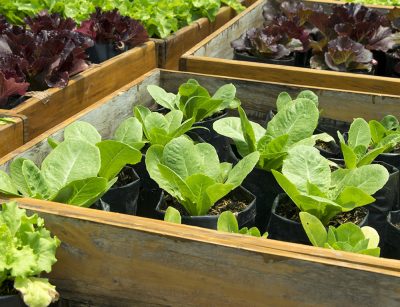
You have probably heard about the recent alarm over e coli found in Romaine lettuce. While relatively few people got sick, in comparison to how much Romaine is sold in grocery stores, the problem is still concerning. This isn’t the first time lettuce has been contaminated with a dangerous pathogen, and it probably won’t be the last.
The problem is that when large farms grow many square miles of crops out in their fields, it is impossible to control every variable that can introduce viruses or bacteria into our food. Animals frequent these fields, and rain or groundwater can become contaminated. There is no perfect system that will always prevent disease outbreaks. Lettuce, in particular, is a susceptible crop because the leaves readily absorb pathogens that aren’t easily washed away.
One way to avoid veggie anxiety is to grow your own food at home. It’s far simpler to control variables within a small home garden, and you can even grow some crops indoors (including lettuce).
Choose a variety of lettuce. Most varieties of lettuce are relatively easy to grow at home but pay attention to the climate if you want to plant your garden outdoors. Lettuce responds better to somewhat cooler conditions than many other vegetables. Temperatures between 65 and 70 degrees are best.
If you prefer to grow lettuce indoors, these varieties are known to perform well in kitchen gardens:
Merlot
Baby oakleaf
Garden babies
Lollo Rosa
Tom Thumb
Black-seeded Simpson
Growing lettuce in pots. If you want to grow your lettuce in pots, choose a sunny window to keep them. Each plant will need at least 8 inches of depth, and a width of at least 4 to 5 inches. Plant seedlings if you want to reduce your growing time, or sow seeds into potting mix about 4 inches deep. Water regularly until plants are well established, and then water as needed (when leaves begin to wilt, your plants are too dry). When watering, just dampen the soil; don’t soak.
Growing lettuce in a hydroponic system. These systems can be purchased as a kit, with everything you need included. Lettuce does grow very well this way, but the kits are more expensive than pots and a sunny window. It’s worth the investment, though, if you’re committed to providing your family with healthy, safe produce.
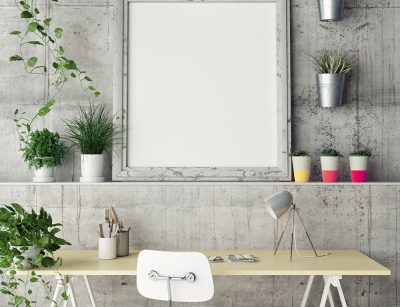
Business managers often research ways to make the office more productive, and are interested in methods of improving employee health and attendance. As we have learned from experience, sometimes the most effective solutions are also the simplest ones! You might be surprised to learn that the addition of a handful of plants in your office can have a drastic effect on morale and health.
Clean the air. Plants absorb carbon dioxide from the air, combining it with light and water to make their own energy. In the process, they release oxygen. We’ve known this for ages, of course, but now recent research indicates that the process of photosynthesis also helps to filter chemicals like benzene, trichloroethylene, and formaldehyde from the air. If you want to breathe cleaner air, a few plants in your office will do the trick.
Reduce stress. Researchers have found that office plants are linked to lower levels of stress, depression, anxiety, fatigue, and even hostility. The field of color psychology has also taught us that green has a calming effect.
Improve health and lower absence rates. Whether due to the cleaner air or psychological effects, several studies have found that offices with plants experience lower levels of illness among employees. Since sick days are one of the primary reasons for absences, office plants might even improve attendance rates.
Increase productivity and creativity. According to attention restoration theory, picturing or experiencing natural elements helps our brains to shift into a processing mode that promotes relaxation and concentration. Memory retention and performance on various tests are also linked to plant exposure.
Make the office more attractive. Of course, the primary reason we often utilize indoor plants is that we simply enjoy their aesthetic appeal. Not only will you appreciate the added touch to your decor; an attractive office is more appealing to clients and job candidates as well.
So, which types of plants grow well in an indoor setting? Stop by our nursery, and we can show you different varieties of ferns, African violets, spider plants, cactus, and more.
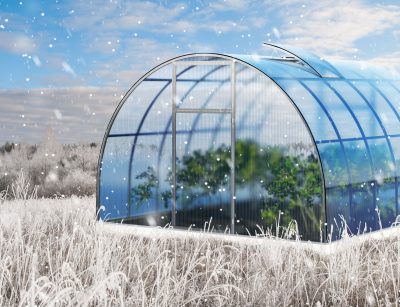
The Perfect Crops for a Winter Greenhouse
Fall has arrived, and winter is on the way. That means no more delicious homegrown, organic veggies, right? Not so fast! Even if you’ve cleaned and covered your garden beds for the cool months, plenty of delicious food crops can be still grown in a winter greenhouse. The following options all perform well in containers, so you don’t need to worry about planting them in outdoor beds.
● Green onions
● Lettuce and other salad greens
● Spinach
● Kale
● Chard
● Radishes
● Beets
● Carrots
● Cilantro
● Strawberries (yes, really!)
These are just a few of the more common winter greenhouse crops. It’s fine to experiment and see what works for you, since all you have to lose is a few seeds and a bit of time waiting (and hoping). You never know what might work!
Planting indoors. The main thing to remember, of course, is that the size and depth of containers should match well to each plant’s needs. Some, like chard and carrots, need a deeper container (at least 24 inches). Others can be planted in more shallow conditions, such as radishes and green onions. Strawberries actually do quite well in hanging baskets that are at least 12 inches in depth.
Spacing is another consideration. Make sure to offer your plants a container that allows room to spread (this is a particular concern with leafy greens).
The temperature will be your other primary concern. While most of these plants will germinate in somewhat cooler temperatures, the soil can’t be too chilly, or they won’t survive. For example, beet seeds can be started as low as 40 degrees, although 50 or above is ideal. Research each crop’s temperature needs in detail.
Finally, you will need to monitor humidity carefully. As with outdoor plants, water your crops if the soil feels dry to the touch and take care not to over-water.
For more specific advice geared to the food crops you hope to grow, give us a call. We can help you select crops that suit your preferences and that should perform well in your greenhouse space.
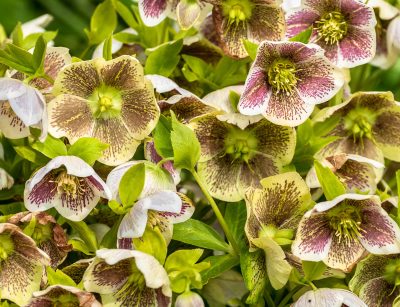
If you’ve ever observed lenten roses – or hellebores, as they are also called – you might have reached the conclusion that these lovely flowers are a delicate and fussy species. After all, their exotic appearance certainly gives off that impression! In reality, lenten roses are hardy (even in colder climates), easy to grow, almost maintenance-free, and prone to few pest problems.
Best of all, lenten roses add gorgeous color and a unique flair to late winter gardens! Once they’re finished flowering in early spring, they lend an interesting and functional groundcover to the garden as warm-season blooms take over.
Choosing a lenten rose. All varieties of lenten rose are about equal as far as requirements, so you can choose one that matches your color and aesthetic preferences. Blooms range in color from white and light pink, to dark pink, green, purple, gray and black. Some varieties also include striped or spotted multicolor blooms. As for the foliage, it may turn bright chartreuse to deep gold, depending upon the variety you choose.
Planting lenten roses. November is the perfect time to plant seedlings in order to reduce your wait time. Lenten roses prefer partial shade, when possible, so choose a spot underneath trees or taller shrubs, or plant your lenten roses alongside a wall. Well drained, slightly alkaline soil is best.
Caring for your lenten roses. This species is relatively low maintenance and shouldn’t attract many pests or diseases. Most of the time, all you need to do is clean out any dead leaves after flowers appear. In the spring, when the plants have stopped blooming, add a fertilizer and relocate seedlings that might have appeared.
Since lenten roses vary significantly in appearance, you might prefer to view established plants in magazines or online. Choose the ones that appeal to you, and we can offer more input on giving your lenten roses a good start in your garden.
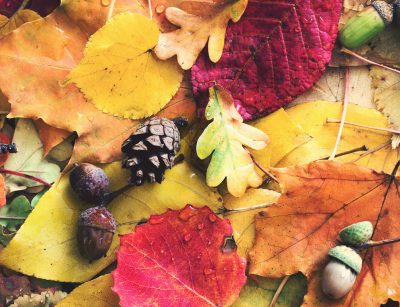
Here in Southern California, we don’t experience a harsh winter, but that doesn’t mean you don’t need to transition your garden into the cooler months. In fact, because our winters are so mild, now is the perfect time to try some new cooler-season plantings and to continue enjoying your garden. A gardener’s November checklist is brief, but an important way to have a safe winter and lush spring!
Clean up leaves. If you have deciduous trees on your property, you will experience a fall leaf drop. You can choose to clean these continuously or wait until all leaves have fallen and perform one big cleanup. It’s a good idea to mulch leaves for later use in beds (see our other blogs on good uses of leaves). Some homeowners prefer to simply leave them on the ground, and that’s okay too. Decomposing leaves add carbon and nitrogen back to the soil and contribute to the growth of beneficial soil microbes.
Address fire safety. One way to fireproof your home is to create a buffer around your property. Remove dead leaves, vegetation, and other flammable materials within thirty feet of the house. Prune back tree limbs that have grown too close to the structure, mow or trim dried ornamental grasses to a height of four inches and eliminate any fuel sources. If trees are overcrowded, this is a good time to address necessary tree trimming chores.
Adjust your irrigation system. With cooler temperatures and increased precipitation (we hope) in the forecast, you can dial down the irrigation system. If your beds contain California natives, succulents, dormant ornamental grasses, and low-water shrubs or trees, you can usually turn off the system entirely until spring. Keep an eye on plant health and adjust accordingly.
Clean up your perennials. Now is the time to pull out dead leaves or rotting stems, and to divide over-crowded perennials like daylilies, asters, and yarrow.
Plant. In November, you can set out cool-season perennials like violas and pansies, to enjoy blooms throughout winter and into spring. The cool season is also a good time to plant many types of California natives if you would like to fill in bare spots with a low-maintenance species.
If you would like assistance in choosing some cool-season perennials or California natives for your garden, come to see us at our nursery. We can help you choose the right plants for your needs and offer more input on proper planting and care of your selections.
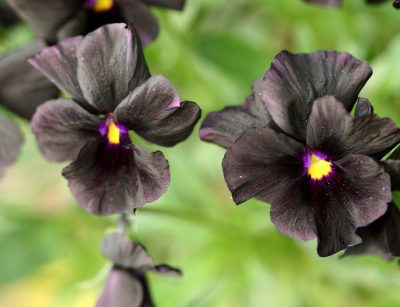
Each Halloween, hordes of ghosts, goblins, monsters, and other creatures come knocking at your door. Many people choose to welcome their trick-or-treaters with a few jack-o-lanterns, themed decorations, or fall blooms on the front porch. If sprucing up the garden and front steps are your thing, we have one more idea for you: How about some cool, unique black plants?
Most people don’t associate black with foliage! But there are several interesting varieties of black plants that are quite simple to add to your landscape, and you can get it done by Halloween if you hurry.
Black mondo grass provides dark, strappy leaves that reach nearly a foot in height. The texture works perfectly for filling out empty spaces in fall gardens and offsets bright orange pumpkins nicely.
Black pansies aren’t actually black, but extremely dark purple. Nevertheless, they provide a lovely, velvety texture and make the perfect accent to lighter colors in the flower garden.
Purple ruffle basil is also more of a deep purple. Its unique texture makes it the perfect complement to a variety of other plantings, plus it’s edible (and delicious)!
Purple Majesty, an ornamental millet, provides dark foliate reminiscent of corn stalks. So, it’s perfect for fall! These do reach three to four feet tall, so choose either a large ornamental planter by the front door or place it prominently in your garden.
Black Scallop Ajuga is a perennial that grows up to two feet tall and wide. Space these far apart in your garden and allow them to fill in areas vacated by long-gone summer blooms.
“Black Heart” sweet potato vine is a low-growing, wide-spreading vine. You can use it in the garden, or let it spill decoratively out of a planter.
Vino Coleus provides dark purple foliage that turns nearly black in the sun. Those little baby plants can eventually reach up to three feet tall and five feet wide, so choose a large planter or a roomy spot in the garden.
To learn more about these gorgeous black plants, or to see what we have in stock, drop by our nursery. We can help you select just the right “spooktacular” plants for your garden.
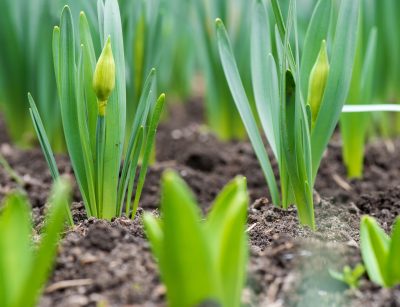
Now that the weather is cooling off, spring and your favorite flowers might seem a long way off. However, the lushest and beautiful spring gardens are actually planned in the fall. Setting out spring bulbs for next year’s blooms might be the perfect family project, as it teaches kids about plant growth cycles. As a bonus, it can also teach patience!
Planting bulbs is easy, but for newbies, here is a quick checklist.
Gather the right equipment. You can certainly use simple hand tools like a spade, trowel, and shovel, but many gardeners swear by bulb planters. They dig quick, easy holes that are just the right depth for bulbs. Plus, they’re easy for kids to use.
Plan. Research the particular flowers you’ve chosen and decide how to space them in your garden. This becomes more complex as you mix varieties of different species and sizes, but the end result is also more dramatic. Correct spacing is important so that you can ensure each plant receives the right amount of light and has enough room to spread.
Dig. Different bulbs have their own unique depth requirements, so check the package. Then, match those to the measurements on the side of your bulb planter. Insert the planter in the ground, then rotate it back and forth until you achieve the correct depth. When you lift the planter out of the ground, the dirt will come with it.
Plant. Now, all you have to do is drop the bulbs into the holes, pointy side up. This seems like a simple task, but most kids find it mildly thrilling!
Cover. Replace the dirt back into the holes, covering the bulbs. Pat firmly, and you’re finished. If you’re worried about an extra dry fall, you can water them lightly if you prefer. However, most bulbs don’t require any watering just yet.
Now, just remember to watch for those early green shoots in the spring. Your kids are sure to be thrilled at seeing their hard work come to fruition!
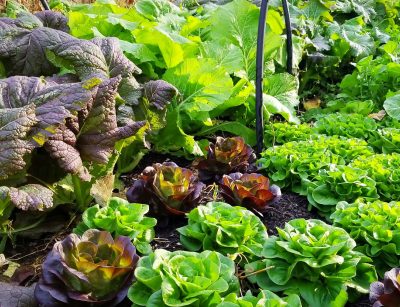
Now that summer has come to an end, and you’ve established your fall garden, what else is left to do? This October gardening checklist should help get you on your way! You could certainly rest and enjoy the fruits of your labor (perhaps literally), or you could get a jump start on preparations for spring. The final choice is up to you, but if you want to take advantage of the free time, here are our suggestions for fall gardening tasks.
Tackle other landscaping projects. Now that much of the year’s planting is behind you, fall is the perfect time to tackle other tasks that have been waiting in the wings. Perhaps your lawn needs reseeding, or you’ve been considering a new pathway, patio, or driveway project.
Consider plantings. While planting of the most sensitive of tropical species should wait until spring, it’s acceptable to plant most other things in California right now. In fact, trees, shrubs, flowers, and grasses are happy to spend the winter establishing their root systems. The increased moisture makes fall and winter an ideal time.
Plant cool season veggies. Just because summer is over, doesn’t mean you can’t enjoy homegrown treats from your own garden! Replace your summer veggie garden with kale, beets, onions, cabbage, broccoli, carrots, or Brussels sprouts.
Cover bare spots. The cooler seasons are the perfect time to plant ground covers for any bare spots that have been bothering you. Consider the space carefully and choose a variety whose needs match the light and moisture of the area and can withstand the amount of foot traffic received.
Plan for spring blooms. Although spring is months away, you should plant certain types of bulbs now. Consider daffodils, tulips, crocuses, and hyacinth. Keep in mind that some bulbs need refrigeration time to trick them into thinking that we had a cold fall!
Think about the birds. Birds are migrating at this time of year and need places to rest and have a sip of water. A birdbath, fountain, or even just a shallow dish of water can help to draw migratory species to your yard.
If you need help with any of these fall landscaping projects, give us a call. We can offer our input, and help you select bulbs, starter plants, or other materials.
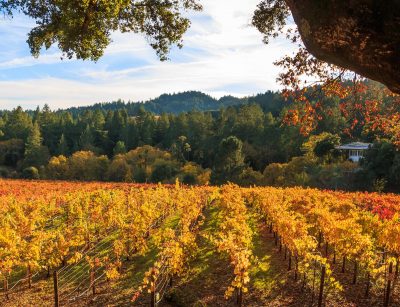
For many of us, our minds associate Fall with hayrides, pumpkin patches, cooler weather, and glorious fall color. But as we know here in Southern California, many of those associations are in our minds! Most of the more dramatic changes that occur along with Autumn will happen on the East Coast and in the North. Meanwhile, we have to get a bit more creative in our area to get fall color in a mild climate.
First, consider whether you have included any deciduous plants or trees in your landscape. Those that are native to locations with milder winters are ideal for our local climate because they will change colors even with a slight variation to cooler weather. Examples include:
● Oakleaf hydrangea
● Japanese maple
● Sweetgum tree
● Dogwood
● Gingkos
● Chinese pistache
● Crepe myrtle
● Japanese persimmon (as a bonus, you can also enjoy the fruit)
● Grape Vines
Of course, as emblematic of Fall as they are, there is no need to rely solely upon leaves. Consider, also, shrubs that produce bright red berries in the cool season. Pyracanthus shrubs flower beautifully in the spring, but also provide a display of fall and winter berries. The bushes are quite drought-tolerant, too, so they won’t require much water throughout the summer.
Finally, there is always the obvious choice of flowers. Chrysanthemums are a clear option as are other annuals and perennials in shades of yellow, red, orange and dusky purple. Intersperse these with some ornamental grasses in brilliant shades of gold, and you can achieve a colorful fall garden in time for Halloween.
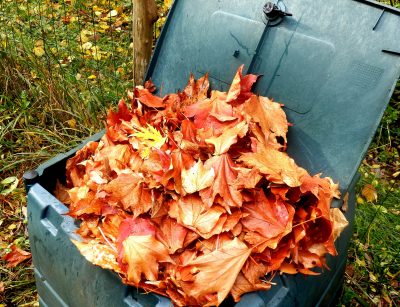
Fall is only just beginning, and spring seems a long way off. So, you’re probably not thinking too much about spring planting! But, we have found that gardeners who tackle these three fall garden tasks find themselves much happier in the spring! In exchange for a little extra work now, you can save yourself hours of labor (and maybe backaches) next March.
Plant a cover crop. Leaving your edible garden beds empty in the winter will lead to nutrient loss over the winter, as well as invading weeds. Planting a cover crop can help to build up the soil and feed your pollinators. And since they won’t require special amendments or a lot of nurturing, cover crops really only require a few minutes of planting time. Try garlic, fava beans, alfalfa, clover, buckwheat, or borage.
Start a compost pile. Why throw food scraps and yard waste into a landfill, when you can create your own rich, nourishing compost at home? As a bonus, you will reduce or even eliminate your need for chemical fertilizers (and save money, too).
Build a large box, use an old garbage can, or simply designate a remote area of your yard to a compost pile. Next, collect “browns” and “greens,” and layer them. “Browns” refers to dead leaves, branches, or twigs, while “greens” refers to grass clippings, vegetables, coffee grounds, and other “wet” plant material. Avoid using weeds or diseased plants, so that you won’t spread unwanted problems into your garden when you use your compost next year.
Next, turn the compost regularly throughout winter to aerate it. The bugs and worms will do the rest of the work for you!
Get your tools ready. You can save this task for winter, when your gardening duties are minimal. Clean your tools thoroughly, then sharpen and oil them. You will do this by mixing a nontoxic oil (such as mineral oil or baby oil) into a bucket of sand, until the sand is just moist. Then plunge the blades of all hand tools, shovels, and pruners into the bucket of sand, in an up-and-down motion. Then, just store your tools somewhere safe and dry until you need them again in the spring.
These fall garden tasks may sound simple (because they are) but the payoff will be well worth it when your spring garden takes off!
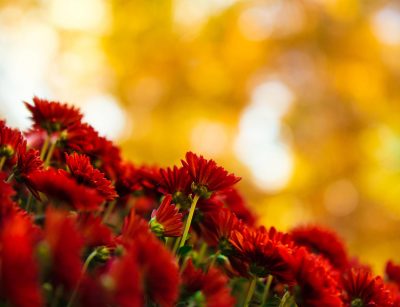
If you’re looking for a full and dense fall bloom that comes in a variety of colors, we have the perfect perennial flower for you. Chrysanthemums reach their prime at this time of year, and they’re very easy to cultivate. Our quick guide will get you started.
Consider size. Chrysanthemums are available in a variety of sizes, from small cushion mums to giant spider mums. Consider the size of your planter or garden space before choosing a plant.
Now, choose your color. You can find chrysanthemums in just about any color, such as green, red, white, pink, orange, yellow, or purple. Scientists are even working on cultivating a true blue mum, though they aren’t quite there yet.
You can choose any color you like, of course, but we’re a bit partial to the fall colors at this time of year. Even better, choose mums in several different colors and group them together. A bright display of orange, yellow, and red mums says “autumn” like nothing else!
Planting your chrysanthemums. Plant your mums now, so that they have time to develop a healthy root system before winter. And, because chrysanthemums are heavy feeders, remember to supplement them with fertilizer throughout the growing season.
The main thing to remember with chrysanthemums is soil quality. Your chrysanthemums will literally rot if planted in soil that is too damp, so choose a well-drained spot. If your soil contains a high level of clay, mix in some peat moss and compost before planting.
Mums love full sun, though some varieties are shade tolerant. A sunnier spot will ensure more blooms, and of course, help to keep the soil drier.
You can also use these perennials in pots (they look fantastic on the porch flanking the front door). Just make sure that you choose a pot that is appropriately sized for their growth.
Pruning. Next year, you can try some interesting pruning techniques on your chrysanthemums. Pinching off early buds before July will double the number of blooms you enjoy in the fall. Or, you can try disbudding in which you remove all side buds to create one large, central bloom.
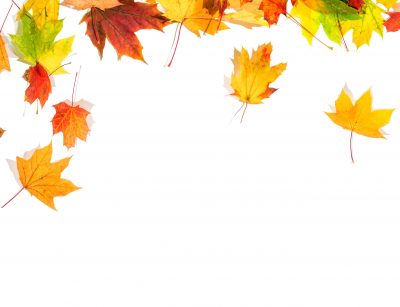
Fall will arrive any day now and with it will come an array of colorful leaves. Are you ready to fire up your leaf blower?
If you’re like most people, you have a leaf blower, or at least a rake, on standby to deal with all that fallen foliage. Then you will either bag them up for the trash truck, or you have arranged for a special service to vacuum and haul them away.
Did you know that you could actually put those leaves to work in your garden? You can even save yourself some time and money by doing so.
Nourish your lawn. Using a mulching mower, simply discharge the mulched foliage back onto your lawn. They will break down over the winter fertilize your lawn with nitrogen and carbon.
Nourish your vegetable beds. Mulched garden refuse can also be used in vegetable beds. If you don’t have a shredder, just fill a large garbage can three-quarters full of leaves, and shred them with a string trimmer.
Use them in your compost pile. For this application, you don’t have to shred the leaves first. You simply throw them into your compost heap, and they will provide plenty of nutrients. In fact, you should hang onto some dried leaves to use next summer, too. Compost needs plenty of “brown” material to keep the aerobic processes going correctly.
Insulate your plants. Here in Southern California, we don’t have to worry much about sub-freezing temperatures. But some sensitive plants might still appreciate some extra insulation during the cooler months.
Make your own mulch. Pile your leaves in a secure place, wet them regularly, and turn them throughout winter. They will decompose into a rich, soil-like mulch that is perfect for your garden beds.
If you have any questions, don’t hesitate to call us. We’ll be happy to help you with all of your gardening needs.
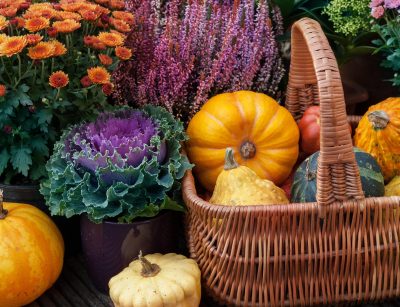
When you think of fall, gardening might not be the first thing that comes to mind. After all, many of us associate spring and summer as “gardening time”, and resign ourselves to viewing fall and winter as boring. That doesn’t have to be true at all! There are plenty of ways to create a stunning fall garden and transition your late summer landscape into an autumn masterpiece.
First, remember to think outside the box a bit. When most people hear autumn, they think of leaves changing color. It’s true that adding a few trees, such as Maple, Chinese Pistache, Elm, Gingko, Sweet Gum, or Mulberry will certainly invite vibrant autumn color into your yard year after year. Don’t limit yourself! A stunning fall garden can be composed of many more elements.
Ornamental grasses. Ornamental grasses provide much-needed texture to the garden, and are perfect for filling in otherwise plain spaces. Choose the right variety, and it will turn a bright red, yellow, or orange color in the fall. Pink Mulhy grass turns a lovely pink/purple color, while Mexican Feather Grass features a bronzy tan color.
Lush shrubbery. We often think of flowering shrubs for the garden, and those tend to bloom in spring and summer. We can also point you toward a variety of shrubbery that work for a stunning fall garden! For example, Hydrangea is lovely throughout summer, but its foliage turns brilliant shades of red, yellow, and orange in the fall. A Rose Bush produces lovely flowers all through the spring and summer and in the fall can feature colorful rose hips.
Consider all life stages. As your fall foliage fades, your perennials, grasses, and shrubs still have something to offer. Many produce seed heads that serve as unique ornamental additions throughout late fall and winter. Leave them, and much of your local wildlife will appreciate the gesture.
Don’t forget negative space. As with all visual art forms, negative space is also utilized in landscape design. Just think how chaotic and overwhelming it would be, to throw hundreds of plants together with nothing else to break up your design! In gardens, negative space can be accomplished by something as simple as a decorative bench, a stone or pebble pathway, or a patio or porch area. Remember to utilize these elements in your design, as they give the eyes a place to rest. A few simple pots of chrysanthemums can accent these areas, with very little effort.
As always, please give us a call as you plan for your fall garden. We can help you select plants that provide color and texture now, and in years to come.
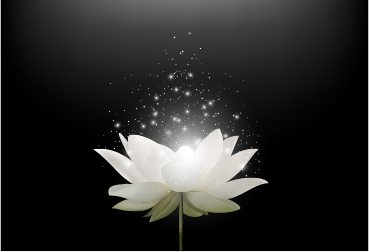
Don’t you just love relaxing on your porch or patio, enjoying warm summer evenings? Perhaps you enjoy entertaining outdoors, or maybe you’re more of an introvert who prefers solitude. But there’s just one little problem: As tranquil as the setting might be, you can’t really enjoy your garden in the dark.
…Or can you? If you grow a moon garden, you will appreciate beautiful blooms even in dim lighting.
Moon gardens tends to be composed of plants that glow in the moonlight, such as white blooms and pale foliage. You can choose anything you wish, but some common choices include:
● Pennisetum “skyrocket” – an annual ornamental grass featuring thin blades with wide, white margins
● Hostas – hostas come in many varieties, but many feature plenty of reflective white coloring on their leaves
● Carex “ice dance” – another thin, strappy leave with white margins
● Brunnera – these large, silver-white leaves are simply gorgeous in the moonlight
● Mandevilla – perfect for a trellis, these vines grow up to five feet and feature white, funnel-shaped blooms
● Petunias – these summer annuals are easy to grow, and are available in white
● Angelonia – featuring spires of white flowers that bloom from spring to fall
● Gardenias – not only are these white blooms quite beautiful; you will enjoy their strong, sweet fragrance on warm summer nights
● Brugmansia – these large white flowers release their strong fragrance at night, making them perfect for a moon garden
● Impatiens – these bloom well in the shade, and their dark glossy foliage seems to disappear at night, making the white blooms appear to float
As with all container gardens, you should pay attention to each plant’s sunlight and water needs, and treat them appropriately. The great thing about containers is that they can be moved! So, if one of your plants seems “unhappy”, you can easily adjust its growing conditions.

